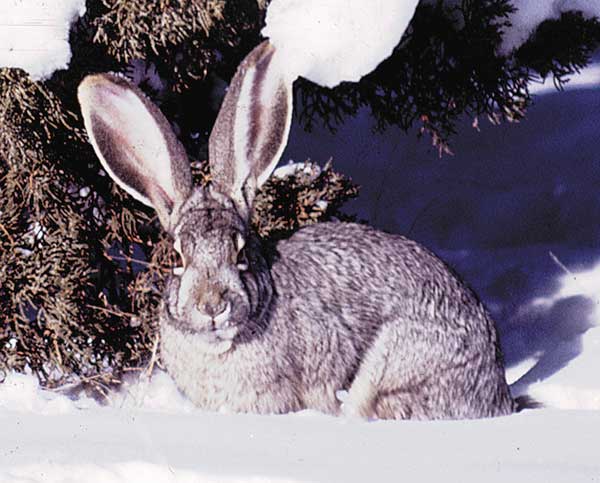 If there is one wild animal that is taken for granted, overlooked in the wildlife management business, completely misunderstood by state agencies and killed relentlessly, it is our poor old black-tailed jackrabbit.
If there is one wild animal that is taken for granted, overlooked in the wildlife management business, completely misunderstood by state agencies and killed relentlessly, it is our poor old black-tailed jackrabbit.
Jackrabbits are actually "hares," not "rabbits;" they're in the genus lepus and are twice as large as our local rabbits, and hares have taller hind legs and longer ears. Cottontail rabbits were named for a puff of fur that adorns their tails, while, on the other hand, jackrabbits were named for their ears, which initially caused some people to refer to them as "jackass rabbits." Mark Twain brought this name to fame in his book, Roughing It. “Jackass rabbit” was, however, just too awkward and the name was later shortened to jackrabbit.
There is also another difference. Rabbits that are in the genus sylvilagus make a nest in which the female gives birth to naked, helpless and blind baby rabbits, known as kits. Pregnant momma jackrabbits don't bother to build a nest and appear to be very nonchalant about where they give birth, but when you study them for a while, you will see some very clever hare-thinking in what they do.
Just before birth, the soon-to-be mother begins to explore the her "home range"—where there is usually plenty of fresh grass to feed on and keep her kits going when weaned—plus another vital habitat element, cover for her babies.
At the end of her "confinement," momma jackrabbit may stop beside a large rock, usually hidden by brush, and give birth to one of the kits. Then she hops—probably very slowly as most pregnant mothers tend to move—to a large clump of sagebrush or rabbit brush and drops another little one. Then perhaps on to a bunch of old juniper roots sticking out from under the tree to drop her third kit.
The little guys are born with hair on their bodies, eyes wide open, ears erect, and they can run like blue-bloody-blazes. Mom sneaks around nursing the hidden youngsters, and if all goes well, they'll be weaned quickly, and grow into strong adults. With the kits stashed in different locations, there's a good chance all three may survive. Even if a coyote stumbles upon one and eats it, it may go off satiated and not go searching for another one.
As some sport shooters will testify, a jackrabbit can leap a distance of 10 feet when shot at. If pursued by a badger, coyote or eagle—or when really pushed—they can get up to about 40 mph between leaps. They also have a neat escape sequence: first they run about 25 yards straight out, crouch and assess the situation. If the threat is still there, they'll run in a zig-zag pattern for about another 50 yards, make a sharp turn and crouch. If that doesn't work, their escape computer crashes and they go straight away as fast as they can go and as far as they can leap.
Just about every wild animal that eats meat depends on the poor old jackrabbit for a meal or two. Among that group are golden eagles. I know that to be a fact as I've been banding golden eagle nestlings for almost 50 years. As part of banding, I always look to see what the eagles are dining on, and the lowly jackrabbit is number one on their favored list of things to eat. The pure and simple fact is that if there are no jackrabbits, there will be a serious decline in eagle populations.
But jackrabbits are not defenseless when caught by a predator. I once watched a jackrabbit tear a great horned owl apart because the owl was sloppy. The hare kicked out with its powerful hind legs, equipped with long, sharp nails and that was it for the poor dumb owl. Such tactics of survival would probably make our friend Charles Darwin smile.
Eagles, on the other hand, usually land on one foot right behind the hare. The other foot flashes out, smashes the jackrabbit in the side and then the eagle hops on top of it, crushing the life out of the animal with unbelievable pressure exerted by the tendons and talons that give eagles their name: raptor—Latin for raptus: to seize.
But the poor old jackrabbit has great weakness, it cannot keep from eating fresh-planted alfalfa hay and other crops. For that reason, we see historical photos showing hundreds of dead jackrabbits in piles higher than a man's head, victims of "rabbit drives." For that reason, jackrabbits were put under the supervision (management) of the Oregon Department of Agriculture where they were (and still are) classified as a "predator" and lumped in with another unfortunate victim, the coyote.
Here in Central Oregon, things are not going well for jackrabbits. They appear to be in the lower end of their cycle, and have been down far too long. Loss of habitat may be a reason for the decline, along with people’s homes in the sagebrush where house cats are allowed to run loose and kill baby jackrabbits. ORVs tearing up the great sandy desert, and changes brought about by the BLM for "range improvement," have also destroyed jackrabbit habitat. Disease is another reason the jackrabbit population is down, but my gut-feeling is sport-shooting may be the key.
So, I'm going to ask all you sport shooters to do the eagles a favor and please lay off jackrabbits. And, if you want to shoot ground squirrels please do not use lead ammunition. Eagles and other raptors ingest the lead with deadly consequences. Lead-free ammunition is available right here in Bend from Nosler, and Barnes also make lead-free bullets. Many thanks!
















